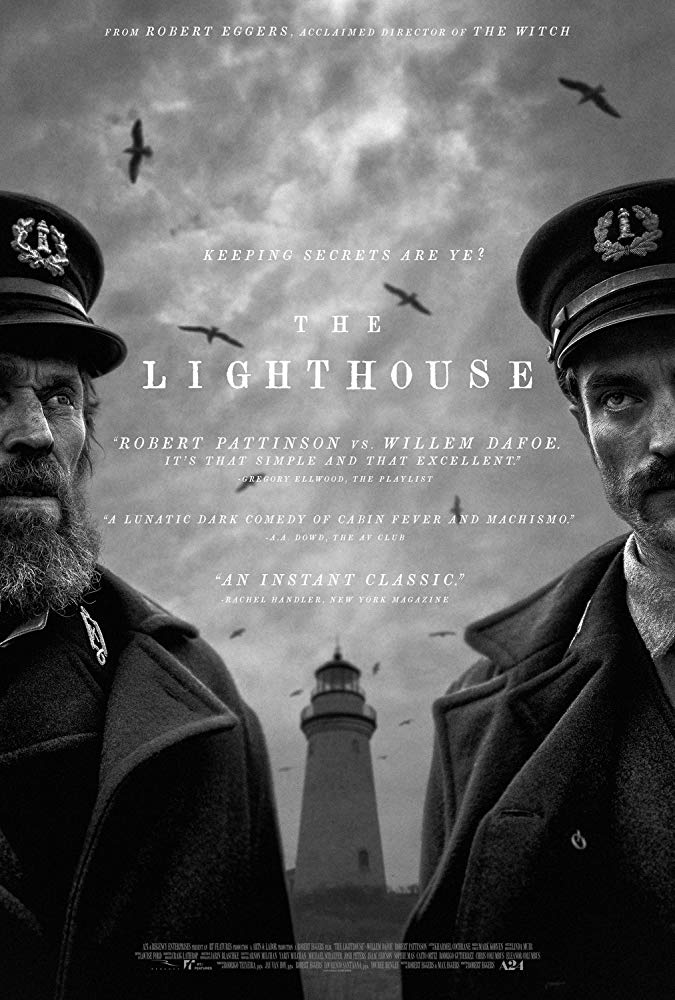By: Ryan Farrell, Staff Writer
Director Robert Eggers recently released his second film “The Lighthouse”, another historically stylized masterpiece. Similarly to his first film “The Witch”, “The Lighthouse” redefines the horror genre with an enchantingly shaded atmosphere. This challenging, dream-like tale is elevated by haunting cinematography, Willem Dafoe and Robert Pattinson’s outstanding performances and a fantastic screenplay written by Robert Eggers and his brother Max Eggers.
In the 1890’s, Ephriam Winslow and Thomas Wake are sent to a mysterious island to fulfill a four week contract where they will maintain a lighthouse, a job title known as a wickie. Wake is an elderly wickie who takes on a leadership role and the keeper of the lighthouse’s light. He functions as a superior, constantly assigning laboring tasks to Winslow, an apprentice. As the weeks pass, the men bond over food and booze. After Winslow challenges the island’s superstitions, a monstrous storm engulfs the island, preventing anybody from relieving them. Stranded and distraught, the two men begin their descent into a drunken madness, wrought with sexual undertones and psychological dysfunction.
The most groundbreaking aspect of “The Lighthouse” is the incredible use of cinematography. Jarin Blaschke, the director of photography for “The Witch”, returned to frame Egger’s new horror masterpiece. The way the shots are executed elevates the film’s mysterious and disturbing components, creating an otherworldly viewing experience. The unique aspect ratio, with an emphasis on the central point of the frame, makes “The Lighthouse” incredibly haunting and memorable. This results in a hallucinogenic array of memorable shots and scenes. It is a format that flourishes in both its comedic, historic and horror elements.
In addition, “The Lighthouse” is also presented in black and white which further adds to its historic feel. Since many scenes are illuminated by candle light, the film is saturated with shadows. The shadows are particularly effective with the stylistic choice, especially with close up shots. It will make the audience feel as if they have discovered a film lost in time.
It is undoubtedly true that the two leads are another highlight of Egger’s masterpiece. The relationship between Dafoe and Pattinson constantly shifts throughout the film as each of their characters spiral downwards. Willem Dafoe’s performance is particularly mesmerizing. He is able to completely immerse himself into the role of a veteran Atlantic seaman. His dialect and accent are essential aspects of the character he portrays.
Robert Pattinson plays the inverse: a young timberman looking for a good living. His mysterious character is certainly an embodiment of madness. He constantly hallucinates throughout the film and Wake suspects him of running from the law. His desire to dissect Winslow’s past adds further tension to their already rocky relationship. Pattinson flourishes in the role and constantly builds off of Dafoe’s intensity.
The musical score of the film is used sparingly but is nonetheless quite effective. It casts a natural ambience that is uncanny and unsettling, often times mirroring the sounds from the lighthouse itself. When the score is absent, the environment adds to the gloomy atmosphere. Indoor scenes are often accompanied by the sounds of the wind crashing against the building, crafting an unsettling tone.
“The Lighthouse” can be viewed at The Nickelodeon Cinemas in Portland

